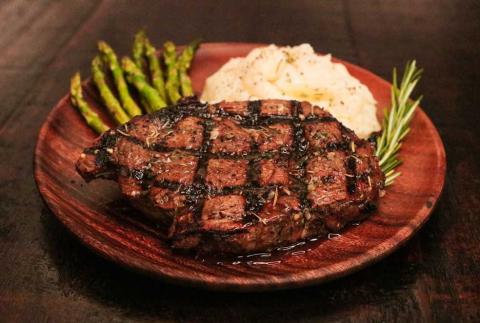David Hawkins
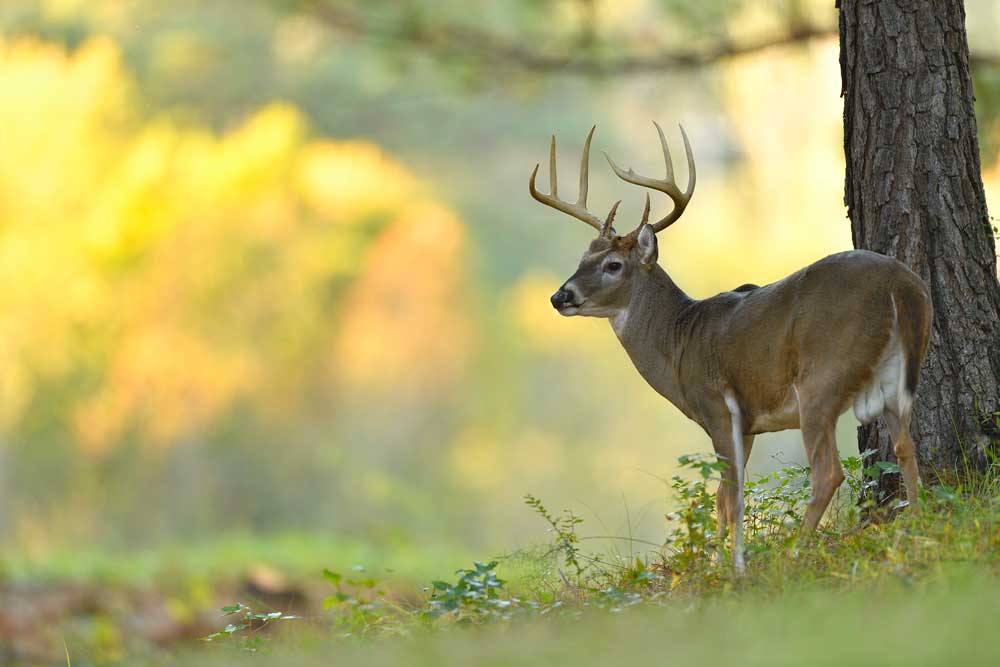
If you’re into wildlife and the outdoors, whitetail management is one of the most intriguing subjects these days. Much research has been done by universities, such as Mississippi State and Auburn. In addition to data acquired through studies of their own controlled deer environments and highly specific herd animals, the universities have collected tomes of data from hunters and land managers; possibly gamekeepers such as yourself. The collection of data is fluid and ever changing, evolving with the environment and indeed the deer.
Just a few counties south of Mossy Oak’s home in West Point, Mississippi are Noxubee and Winston Counties. It was in those counties that the first Deer Management Assistance Program (DMAP) originated. That small pilot program grew in scope over the ensuing decades to include every state in the union with a huntable whitetail population.
“IT’S ABOUT CREATING A LEGACY FOR ALL FUTURE GENERATIONS. SUBSCRIBE TODAY!”
In a nutshell, the program allows participants to benefit from the cumulative knowledge gleaned from other clubs and landowners across the state. At the heart of the program, from the sportsmen’s standpoint, is the collection of accurate harvest data. Each deer harvested in a season-year is weighed, measured, checked for specific conditions and their jawbone extracted. Biologists then catalog the data and examine the jawbone to determine the age of the deer at the time of harvest.
The average hunter can quickly see antler size, hoof-sloughing, sex, weight, if a doe is wet or dry, the obvious and apparent physiognomies. However, aging a jawbone may present something of a conundrum for the untrained hunter.
Before we go further, it’s important that you understand a few words and terms.
JAWBONE GLOSSARY
- Premolars – Used for cutting and grinding food are called P1, P2, and P3.
- Molars – Used for grinding and chewing, these are the three large teeth in the back of the jaw.
- Enamel – The hard white outer coating of a tooth.
- Dentine - The soft dark inner core of a tooth.
- Lingual Crests – The sharp tall tooth edges on the tongue side of the jawbone.
- Buccal Crests – The short tooth ridges on the cheek side of the jawbone.
- Infundibulum – The dark depression between the buccal and lingual crests of the teeth.
- Back Cusp – A shelf-like surface on the very back of M3, the last molar in the jaw.
- Incisor Teeth – The very front teeth in the lower jaw, of little use in aging.
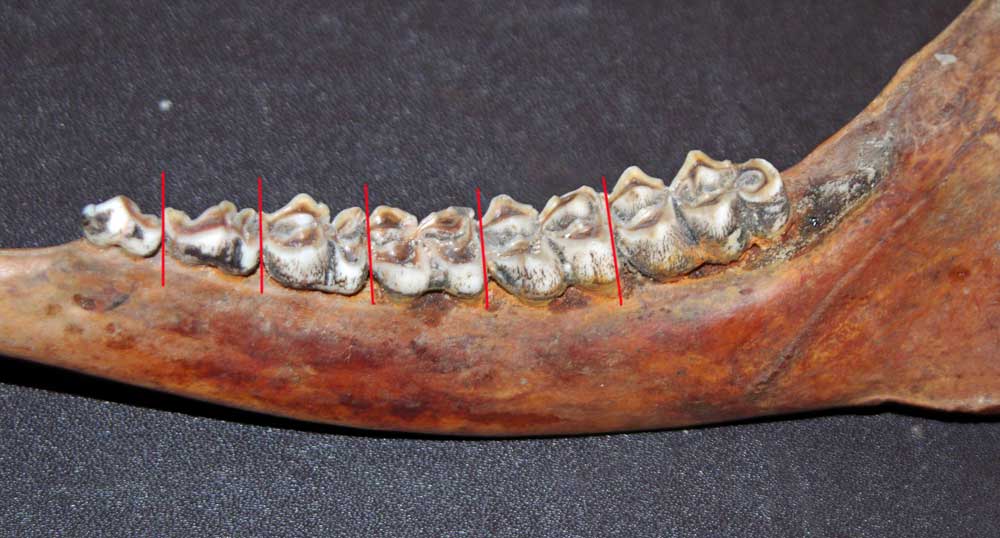
Fawns are pretty straight forward, really old deer (eight years or older) are also pretty easy to judge, but it’s those three to five year olds that can perplex even the seasoned hunter. I hope that this article will leave you, the reader, with a better understanding of jawbone aging and assisted deer management. After all, it’s not rocket science. Every hunter should be keeping data on every deer harvested whether that data is shared or simply used to improve your own herd management.
Use of the DMAP criteria pretty much covers everything that needs to be recorded from harvested deer. Further individualization could include specifics such as precise location, food source, animal activity (making scrape, chasing doe), and time of day. This can be considered as optional information. However, you’re wise to record it in your hunting journal.
Be as accurate as possible and include every animal harvested. I know of no hunter who has been spared the agony of ground shrinkage or the ire it can generate in some hunting circles if your 250-pound buck with 140-inch antlers is really only 180-pounds with a 120-inch rack, but don’t fudge on the data, tell it like it is. It’s vital to proper overall management.
“IF YOU LOVE WILDLIFE AND WANT TO IMPROVE HABITAT SUBSCRIBE TODAY!”
Jawbones may be roughly divided into two categories ― deer under 1.5 years (fawns or yearlings), and 2.5 years and older. Those deer over six years of age are rare and are lumped into the 6+ years and over group. Younger deer are easier to age but harvesting young deer (specifically bucks) goes against most quality deer management plans. Small deer may be harvested if recommended by a qualified wildlife biologist, in those areas where over-population necessitates.
Both bucks and does have the same teeth, thus gender does not matter in the overall aging process. To age a jawbone, it must first be extracted from the head. The process is a bit tricky for novices at first, but experience refines the procedure. (See the side bar explaining the step-step process and offering a few tips that make it easier).
Deer are not unlike humans in the sense that teeth start as temporary and grow into permanent sets. Most mammals share this characteristic. Teeth are divided into incisors, which have little value in the aging process, premolars, sometimes called “milk teeth” or “baby teeth” (later replaced with permanent teeth) and molars. The molars are vital in judging the age of an adult deer accurately. From the front of the jaw, the teeth are P1, P2, and P3, followed by M1, M2, and M3. A deer’s age is usually expressed in ½ years. Dr. Bronson Strickland of the Mississippi State University Deer Lab explains why.
“Deer are born in the spring or early summer, and harvested in the fall and winter. From birth to winter of the first year i\s thus six months. Then age to hunting season of the second and subsequent years are counted in full years,” Strickland said. “I have to point out that aging is a best estimate situation.”
AGING WHITETAIL BUCKS ON THE HOOF
Aging Fawns and Yearlings Jawbones
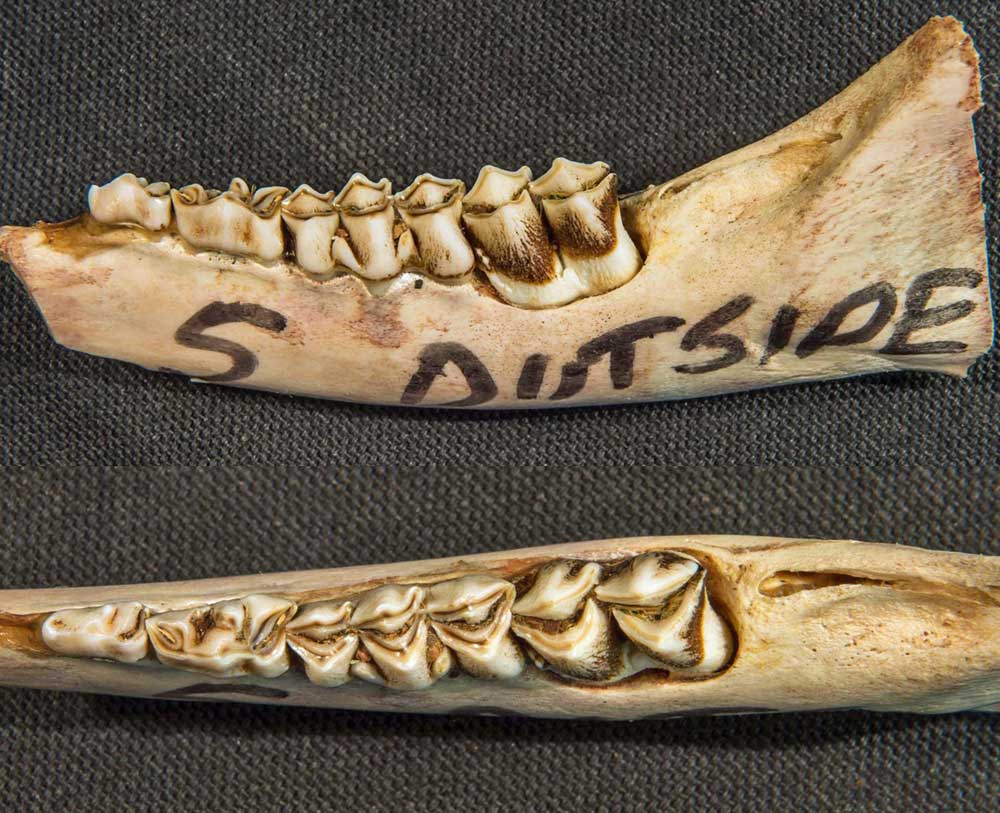
.5 Year Old Fawns
This is the easiest group to age. The key to recognizing this group is the number of teeth, the presence of milk teeth, and a very short jawbone. P3 is a three-crested temporary tooth and M1 will be the only molar present.
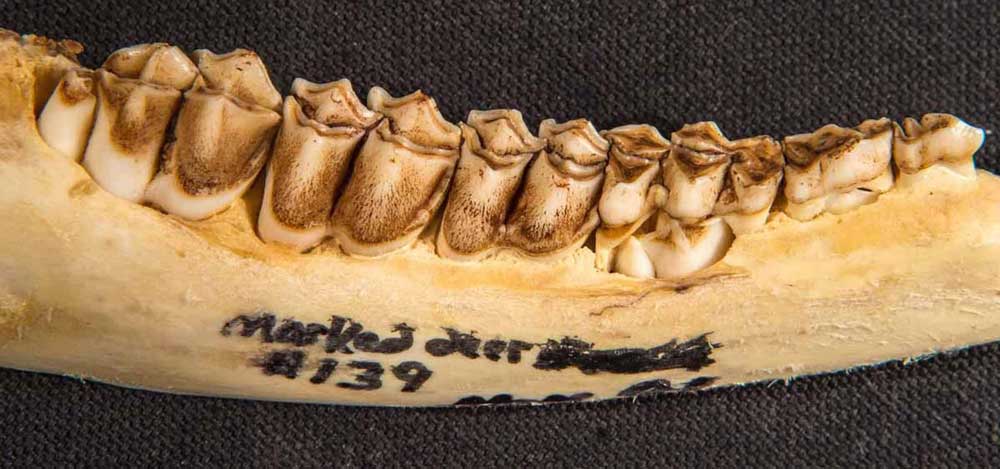
1.5 Year Old Yearlings
The key to identifying this age group is the presence of six jaw teeth, but the decisive factor is the third tooth, P3. In this first full year of growth, the three-crested P3 will be replaced by a two-crested permanent tooth. This, however, is not conclusive if the animal was born early or harvested late in the season. The sixth tooth, M3 may not be fully erupted. If P3 is very white, has two crests and shows no wear, you can bet you have a yearling.
Aging an Adult Deer Jawbone
2.5 year Old Deer
The presence of all six permanent teeth in the lower jaw is the first indicator. P3 will be a permanent two-crested tooth, and M3 is completely grown in, or erupted. The dentine width (the hard dense bony tissue forming the bulk of a tooth) beneath the enamel on the lingual crests (tongue side) is equal to, or narrower than one strip of the surrounding enamel (the thin outer covering of a tooth). Little or no dentine is showing on the lingual side of the second crest of M3. The back cusp on M3 may be worn level but is not slanted.
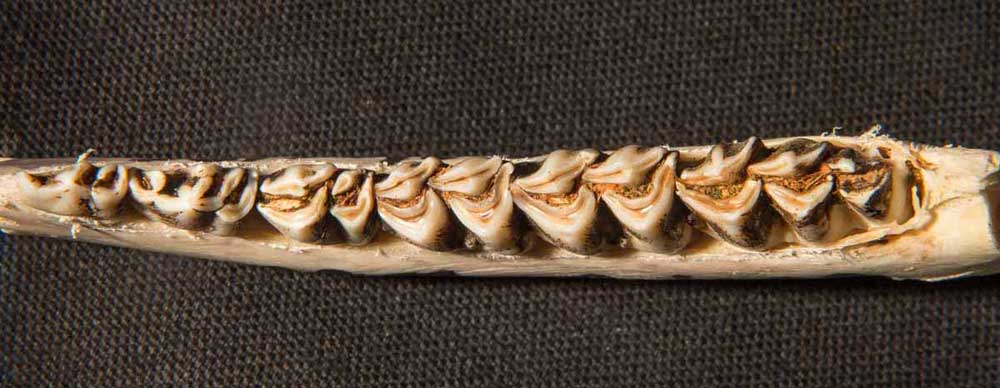
3.5 Year Old Deer
The dentine width on the lingual crests of M1 is noticeably wider than one strip of the surrounding enamel. The dentine width on M2 and M3 is equal to or narrower than one strip of the surrounding enamel and light to moderate wear is evident on P1, P2 and P3. Dentine is showing slightly on the lingual side of the second crest of M3. The back cusp of M3 is begging to show wear and is often slanting toward the buccal side. The key to identifying this group from the previous group is the width of the dentine on the first molar M1, the presence of dentine on the second lingual crest of M3, and the presence of moderate wear on the back cusp of M3.
4.5 Year Old Deer
The best way to distinguish between 3.5 and 4.5 age groups is by the dentine width on the lingual crests of M2 and by the wear pattern of the back cusp on M3. Dentine is very pronounced on both lingual crests of M3. The back cusp of M3 is showing pronounced wear and slanting sharply to the buccal side of the jaw (cheek side). Wear is more pronounced on P1, P2, and P3. And the lingual crests of P3 may be starting to erode away. The dentine on the lingual crests of both M1 and M2 are noticeably wider than one strip of the surrounding enamel. The dentine width on M3 is equal to or narrower than one strip of the surrounding enamel.
“BECOMING A GAMEKEEPER IS NOT JUST THE BEST WAY TO PRODUCE GREAT HUNTING… IT’S THE BEST LIFE! SUBSCRIBE TODAY.”
5.5 Year Old Deer
This age group is what you’re striving for with good management efforts; Older, mature deer that are starting to peak in physical condition. Deer 4.5 and 5.5 years of age are often difficult to separate. The key here is paying close attention to the dentine width on the lingual crests of M3 and the wear on P3 and M1. The dentine width on the lingual crests of all the molars is noticeably wider than one strip of the surrounding enamel. M1 is showing significant wear but the infundibulum remains intact (The infundibulum of a tooth is the funnel-like center that is filled with cementum. The funnel is widest at the top (crown) which is the grinding surface). Wear is becoming heavy on P1, P2 and P3 and the crests of P1and P2 are worn nearly flat. The back cusp on M3 is showing signs of cupping and has a pronounced slant to the buccal side of the jaw.
6.5 Year Old Deer and Older
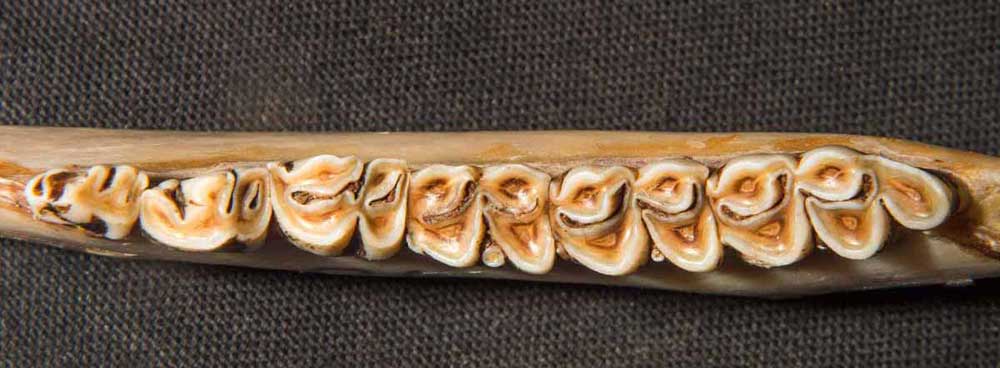
This deer could use some serious dental work. The back cusp on M3 is deeply cupped and heavily worn. The dentine width on all the molars is noticeably wider than the surrounding enamel. M1 is heavily worn and the infundibulum is beginning to wear away. Wear is very heavy on P1 through P3 and the lingual crests on those teeth and M1 are worn nearly flat. The back cusp of M3 and the wear erosion of the crests on P3 are one of the keys to judging the age of this deer.
There are obviously other factors in addition to tooth wear and dentine width one can consider when aging deer ― such as body size, antler development, muscle tone, shoulder and neck dimensions and even muzzle coloration. Bucks may have scars on ears from previous buck encounters that have all but healed and tarsal gland staining is another indicator at early ages. Gamekeepers have the luxury of capturing a great deal of data prior to considering the jawbone.















